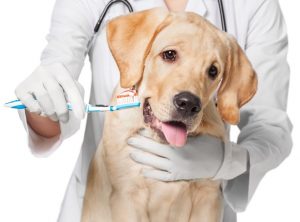Paws-itive Press
Give your pet the best treat, a healthy smile! February is National Pet Dental Health Month!
By Cristina Anzures
Dental health is a very important part of your pet’s overall health. Dental problems can cause other health problems. Your pet’s teeth and gums should be checked at least once a year by your veterinarian to check for early signs of a problem and to keep your pet’s mouth healthy.
Radiographs (x-rays) may be needed to properly evaluate the health of the jaw and the tooth roots below the gum line. Because most dental disease occurs below the gum line, where you can’t see it, a thorough dental cleaning and evaluation are performed under anesthesia.
Anesthesia free dental procedures are not able to clean beneath the gum line to prevent periodontal disease, nor are they able to look beneath the gum line to identify problems before they come painful and expensive to treat. When choosing your pet’s dental care, it’s important to learn about a comprehensive veterinary dental cleaning, also known as a professional dental cleaning, and its long term benefits for your pet’s overall health.
Full grown dogs have 42 teeth and full grown cats have 30 teeth. Before their adult teeth grow in, though, their baby teeth have to fall out. Sometimes, not all of the baby teeth want to come out. This can lead to problems like gum irritation and tartar buildup.
Also, keep in mind that sometimes pets are very good at hiding pain – you might never know that your pet has a serious dental problem until it’s very advanced. Pets that don’t get dental care can painfully lose their teeth – this can be terribly painful and cause serious health problems.
If you have any questions or concerns or notice any of the signs below, you should always visit or call your veterinarian – they are your best resource to ensure the health and well-being of your pets.
Signs of oral and dental diseases in dogs and cats
– Bad breath
– Loose teeth or teeth that are discolored or covered in tartar.
– Your pet shies away from you when you touch the mouth area.
– Drooling or dropping food from the mouth
– Bleeding from the mouth
– Loss of appetite or loos of weight (this combination can result from diseased of many organs)
Although cavities are less common in pets than in people, they can have many of the same dental problems that people can develop:
– Broken teeth and roots
– Periodontal disease: most dogs over the age of 3 years have some sort of periodontal disease.
– Abscesses or infected teeth
– Cysts or tumors in the mouth
– Malocclusion, or misalignment of the teeth and bite
– Broken (fractured) jaw
– Palate defects (such as cleft palate)


